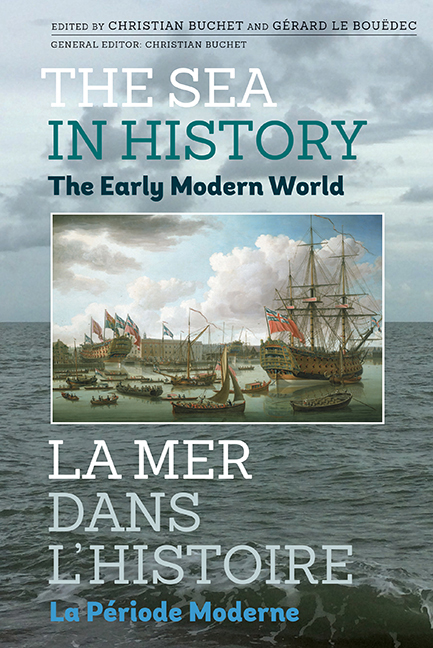Book contents
- Frontmatter
- Contents
- List of Illustrations
- List of Contributors
- Introduction générale et remerciements par
- General introduction and acknowledgements
- Introduction (français)
- Introduction (English)
- LA RÉUSSITE PAR LA MER:La reussite par la mer des territoires et des communautés littorales
- La construction d'un espace mondial: La circulation maritime et les ports
- La forte croissance de l'économie des pêches et des échanges
- Les acteurs de la dynamique maritime
- LA PUISSANCE MARITIME INSTRUMENT DE LA PUISSANCE POLITIQUE ET D'UNE STRATÉGIE GLOBALE DE RAYONNEMENT VOIRE DE DOMINATION: Les puissances maritimes occidentales
- L'océan Indien, entre convoitises et indifférences
- Les puissances maritimes asiatiques
- L'Afrique
- La politique maritime et l'idéologie
- Mer et développement technologique
- Développement maritime et maîtrise économique et financière
- Développement maritime et maîtrise organisationnelle
- Les gens de mer et l'Etat: la mobilisation navale en Europe
- The necessity and consequences of internationalisation: maritime work in the Dutch Republic in the 17th and 18th centuries
- The professionalisation of the English navy and its administration, 1660–1750
- L'état espagnol et le commerce colonial
- The Peruvian Viceroyalty and the Pacific
- The control of landing operations
- Conclusion (français)
- Conclusion (English)
- Conclusion générale par
- General conclusion by
- Miscellaneous Endmatter
- Miscellaneous Endmatter
The Peruvian Viceroyalty and the Pacific
from Développement maritime et maîtrise organisationnelle
Published online by Cambridge University Press: 11 May 2017
- Frontmatter
- Contents
- List of Illustrations
- List of Contributors
- Introduction générale et remerciements par
- General introduction and acknowledgements
- Introduction (français)
- Introduction (English)
- LA RÉUSSITE PAR LA MER:La reussite par la mer des territoires et des communautés littorales
- La construction d'un espace mondial: La circulation maritime et les ports
- La forte croissance de l'économie des pêches et des échanges
- Les acteurs de la dynamique maritime
- LA PUISSANCE MARITIME INSTRUMENT DE LA PUISSANCE POLITIQUE ET D'UNE STRATÉGIE GLOBALE DE RAYONNEMENT VOIRE DE DOMINATION: Les puissances maritimes occidentales
- L'océan Indien, entre convoitises et indifférences
- Les puissances maritimes asiatiques
- L'Afrique
- La politique maritime et l'idéologie
- Mer et développement technologique
- Développement maritime et maîtrise économique et financière
- Développement maritime et maîtrise organisationnelle
- Les gens de mer et l'Etat: la mobilisation navale en Europe
- The necessity and consequences of internationalisation: maritime work in the Dutch Republic in the 17th and 18th centuries
- The professionalisation of the English navy and its administration, 1660–1750
- L'état espagnol et le commerce colonial
- The Peruvian Viceroyalty and the Pacific
- The control of landing operations
- Conclusion (français)
- Conclusion (English)
- Conclusion générale par
- General conclusion by
- Miscellaneous Endmatter
- Miscellaneous Endmatter
Summary
ABSTRACT. The sea played a very important role in connecting populations and developing exchanges along the Pacific coast of Central and South America. Trade induced numerous activities, starting with naval construction, and was at the start of the creation of a powerful merchant community that contributed to the economic development of the Viceroyalty of Peru as well as that of Spain.
RÉSUMÉ. La mer joua un rôle très conséquent dans la mise en relation des populations et le développement des échanges sur toute la façade pacifique de l'Amérique Centrale et du Sud. Ce commerce induisit de nombreuses activités, à commencer par la construction navale, et fut à l'origine de la constitution d'une puissante communauté marchande qui contribua au développement économique de la Vice-royauté du Pérou et incidemment à celui de l'Espagne.
When it was established in 1542, the Peruvian Viceroyalty encompassed all South America, with the exception of Venezuela and the Portuguese overseas territories. The eight audiencias which formed part of the Viceroyalty of Peru (Panama, Bogota, Quito, Lima, Cusco, Chile, Buenos Aires and Charcas) were substantially reduced in the 18th century. The first three were merged, to become the Viceroyalty of Nueva Granada; and Buenos Aires and Charcas formed the Viceroyalty of Rio de la Plata. From 1808 onwards the Peruvian Viceroyalty was challenged by various regional independence movements, and finally came to an end in December 1824.
The political, cultural and economic centre of the huge territory covered by the Viceroyalty of Peru was Lima. This city was founded on an area that had been significant to a sequence of pre-Columbian cultures which had settled in the Rimac Valley; and there were also some other important cities, such as Cusco and others, which had been significant settlements prior to the arrival of the Spanish. Native populations suffered an important decline during the first century of the Spanish rule, mostly as a result of epidemics, but also through violence and wars. Even so, the indigenous peoples continued to be the single largest ethnic component within the total population. Spaniards and Africans formed a small portion of this total, and, with time a new group, the mestizos,increased substantially.
- Type
- Chapter
- Information
- The Sea in History - The Early Modern World , pp. 879 - 890Publisher: Boydell & BrewerPrint publication year: 2017



